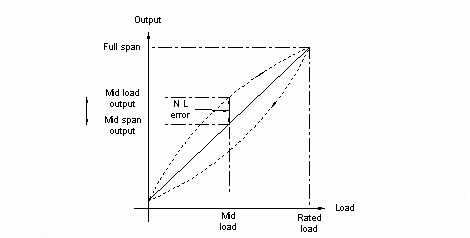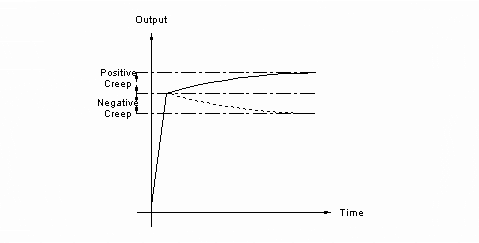This sheet deals with non-linearity, hysteresis and creep. These errors are the most commonly considered errors in loadcell applications and their significance needs to be understood in the context of your application. This is because all of the errors may not have an effect in your application. The following sections define the error in practical terms and mathematically.
Non-linearity


If measurements are being made in one direction only the non-linearity describes how the reliance upon a linear output, which is normally assumed for scaling on amplifier or meter, can lead to the linearity error being applied to the measurement point over the entire range of the loadcell. It is important also to note that the error varies over the range of the loadcell, and the figure quoted is the likely maximum. If a specific combination or single point measurement is of interest we can calibrate to this point therefore eliminating linearity error. Applications employing digital signal processing may create a database of the loadcell’s characteristics eliminating the reliance upon a linear output characteristic.
Hysteresis
Hysteresis is a familiar engineering term. If a force measurement point is achieved by increasing the force from zero and then the same force measurement point is achieved by decreasing the applied force from say the loadcell rated load, a small variation in loadcell output may occur. Our hysteresis data is achieved by using the mid load point as the reference point to calculate hysteresis during an incremental and decremental calibration of the loadcell.

![]()
Hysteresis is really only a problem when reverse load cycles are occurring and the measurement point can be achieved incrementally or decrementally, i.e. if the measurement point is always achieved by increasing the load then no hysteresis error will result. Note that although no hysteresis is present, non-linearity error will be.
Combined Error
As non-linearity can play a part in the calculation of hysteresis, it is sometimes useful to combine both non-linearity and hysteresis effects in a combined form whereby the greater of the two mid load errors, one incremental the other decremental, is quoted. We rarely use this method as our market feedback informs us that a more thorough analysis of defined non-linearity and hysteresis is preferred.


This is only one of a number of possible definitions for combined error, always ask for an exact definition for any combined error specifications that you are given.
Creep
Creep is the change in loadcell output that occurs with time when a constant load is applied with environmental and other variables remaining constant. Creep is specified over a fixed time period, often 20 minutes.

![]()
In dynamic applications creep is rarely a problem unless it is very high or the application requires very accurate measurements. Creep can be a major error in measuring static or slowly changing loads as the output changes due to creep cannot be distinguished from the actual changes in load.
